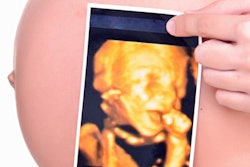
Imaging can aid in the prenatal diagnosis of severe placenta accreta spectrum (PAS) disorder, according to an article published May 26 in the American Journal of Roentgenology.
A multi-institutional team found that the placental bulge sign identified on either prenatal MRI or ultrasound showed strong performance in identifying severe PAS. This imaging finding, which is representative of deeper venous invasion, could help guide maternal counseling and decisions on whether to treat the disorder with a hysterectomy or uterine-preserving surgery, according to senior author Dr. Manjiri Dighe of the University of Washington School of Medicine and colleagues.
The retrospective study included 62 women with clinically suspected PAS who had received both ultrasound and MRI exams.
| Accuracy of placental bulge sign for diagnosing severe PAS | ||
| Ultrasound | MRI | |
| Sensitivity | 91.7% | 94.4% |
| Specificity | 76.9% | 84.6% |
| Accuracy | 85.5% | 90.3% |
Placental bulge was an independent predictor of severe PAS on ultrasound (odds ratio, 8.94) and MRI (odds ratio, 45.67).
"The findings suggest strong performance of placental bulge in diagnosing severe PAS on both ultrasound and MRI, with potentially relatively stronger performance on MRI," Dighe and colleagues wrote. "Nonetheless, interobserver agreement remains suboptimal on both modalities."


.fFmgij6Hin.png?auto=compress%2Cformat&fit=crop&h=100&q=70&w=100)





.fFmgij6Hin.png?auto=compress%2Cformat&fit=crop&h=167&q=70&w=250)











